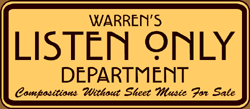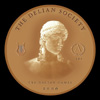COMPOSITIONS by WARREN PARK
•
SOLO PIANO MUSIC
•
MUSIC FOR SMALL ENSEMBLES
•
VOCAL & CHORAL MUSIC
•
COMMISSIONS
• ARRANGEMENTS
 Click
on this symbol to see a 2-page sample from the middle of the score described
to the right.
Click
on this symbol to see a 2-page sample from the middle of the score described
to the right.  Click this symbol to hear complete recordings of the pieces, whenever possible.
Click this symbol to hear complete recordings of the pieces, whenever possible.
ANCIENT WINDOWS, six modern miniatures for intermediate pianists (Cat. No. p002). This is a set of brief modal sounding piano solos for players at intermediate level who like melodic character and moderately challenging rhythms. Entertaining and easy to listen to. Each tune is from 1:41 to 2:59 in length; total time is twelve and a half minutes.






mvt. I

mvt. II

mvt. III

mvt. IV
WOODWIND QUARTET #3, Newfoundland (flute, oboe, clarinet, bassoon) (Cat. No. e002). This is a serious and demanding four-movement piece for advanced players. The flute doubles on piccolo especially in the final movement. This is very accessible modern music that thoroughly explores the different color combinations that these woodwinds can produce. The harmonies tend to favor modal scales. A very rewarding piece to learn, especially good for players who enjoy showcasing their skills. This piece was written in Newfoundland in summer 1972, revised in 1978. Duration about twenty minutes. The sheet music for this four-movement composition was printed using hand-done score and parts, prior to the computer age. The music has GBC plastic binding combs for the booklets the performers use. This sheet music is FREE of CHARGE to serious performers. Movement times: 1) 5:28, 2) 4:46, 3) 6:46, 4) 5:28.

woodwind quintet version

version 1

version 2

version for tenor sax, piano and bass
MESMER'S WALTZ for tenor sax, piano and bass (Cat. No. e005a, e005b or e005c). Dr. Franz Mesmer is an early 1800's physician who experimented with the use of hypnotism as a medical remedy. His name originated the terms 'mesmerism' and being mesmerized. This piece has an old-fashioned feel to it, with mesmerizing flowing patterns that make good use of modal harmonies. It is a piece that Dr. Mesmer himself would have have appreciated. The trombone version uses the high lyrical range of the instrument quite a bit (the highest note is an octave above middle C). e005a: trombone; e005b: French horn e005c: tenor saxophone. (6:29)


(Cello and Bass Clarinet)

(Violin and Bassoon)

(Music Box Waltz)

(Modal Myth)
 (Story Spinning)
(Story Spinning)

Fall 1998

10/28/12
MERGER POEM
And then
all that has divided us will merge
And then compassion will be wedded to power
And then softness will come to a world that is harsh and unkind
And then both men and women will be gentle
And then both women and men will be strong
And then no person will be subject to anotherís will
And then all will be rich and free and varied
And then the greed of some will give way to the needs of many
And then all will share equally in the Earth's abundance
And then all will care for the sick and the weak and the old
And then all will nourish the young
And then all will cherish life's creatures
And then all will live in harmony with each other and the Earth
And then everywhere will be called Eden once again. © Judy Chicago,
1979
REMEMBER ME text by Warren Park
Save
my place at our family* table,
This empty chair will suit me well.
Now that I'm gone, I long to join you again,
Let me sit here a while with you.
Remember me, remember me,
I once belonged in this cheerful circle.
Remember me, remember me, I know every voice, every laugh, every smile--
and you knew mine.
Save
my place at our family* table,
This empty chair will suit me well. It's good you've kept this joyous
time revered,
Even departed souls may join
this overflowing happiness. Remember me, remember me,
I long to share my song with you, This comforts me, this comforts me,
It pleases me to see your joy restored,
Save my place at this festive table,
My favorite chair feels safe and welcome.
Your
lovely faces still shed warmth so easily,
I feel your love for
me still freely flowing.
This
bond among you grows ever stronger.
May you always stay close to one another,
May you know peace,
May you remember me.
*use Christmas if appropriate © 1998 Warren Park

for alto

for soprano
The RHODORA by Ralph Waldo Emerson
In May,
when sea winds pierced our solitude,
I found the fresh Rhodora in the woods,
Spreading its leafless blooms in a dark nook,
To please the desert and the sluggish brook.
The purple petals fallen in the pool,
Made the black water with their beauty gay,
Here might the redbird come his plumes to cool
And court the flower that cheapens his array.
Rhodora! If the sages ask thee why,
This charm is wasted on the earth and sky.
Tell them, dear, that if eyes were made for seeing
Then beauty is its own excuse for being,
Why thou wert there, o rival of the rose,
I never thought to ask, I never knew.
But in my simple ignorance, suppose
The self same power that brought me here
Brought you.

A CRADLE SONG text by William Blake
Sweet dreams
form a shade, o'er my lovely infant's head,
Sweet dreams of pleasure streams by happy silent moony beams.
Sweet sleep, with soft down, weave thy brows an infant crown.
Sweet sleep, angel mild, hover o'er my happy child.
Sleep, sleep, happy child, all creation slept and smiled;
Sleep, sleep, happy sleep, while o'er thee thy mother weep.
Sweet babe, in thy face, holy image I can trace.
Sweet babe, once like thee, thy maker lay and wept for me.
Wept for me, for thee, for all, when he was an infant small,
Thou his image ever see, heav'nly face that smiles on thee.
Smiles on thee, on me, on all; who became an infant small.
Infant smiles are his own smiles, heav'n and Earth to peace beguiles.

(recorded 5/8/16)

Green Laughter of Spring text by Rev. John Cummins
I am struck
dumb with wild and wordless wonder
That on this planet, hurtling 'round the sun,
The green laughter of Spring rises to clothe
Our Earth through cell and seed and birth--
Eternally, in spite for winter storms and cold.
Through ages of fire and ice the flow of life
In countless deaths and multi-million forms
Has known the con-fraternity and miracle of birth;
This, my miracle, my resurrection of the flesh:
Too vast, too true for little creeds, is
Spring's unbridled mirth!
WITHIN YOUR EYES (Cat. No. v006a or v006b) for Soprano and Piano, or with additional C instruments (2 parts) and Bb instruments (2 parts)--this audio sample features this folk band arrangement. This original song is a very sentimental traditional-style song that hearkens back to the pop songs of the 1930's, and old English folk songs too. It is a tune appropriate not only for services and concerts, but for weddings too, either within the ceremony or afterwards. The style imitates traditional songwriting with some uneven phrasing and interesting patterns.v006a is in the key of G, high G is the top note in the range; v006a designates soprano and piano version alone, v006b has the additional instrumental parts mentioned above. Please specify the Key of G in which high G is the highest note for the soprano, or Key of E, where E above high C is the highest note. (4:49)
WITHIN YOUR EYES text by Warren Park
1) How many
shades of greens and blues reveal themselves when love is new?
And how many fragrances sweeten the breeze within our meadow by the sea?
All is in harmony, these blossoms and trees, tall grasses and reeds all
agree--
They all seem to bow before you and me.
CHORUS:
Glorious
skies shine over us, and joyous lives lie before us, Our hopes and hearts
are aligned, within your eyes our love abides,
And our glistening future lies.
2) How many
thousands of violets seem to know they encircle us like a dream?
And how do they already know our song, as boughs of linden leaves wave
us on?
(second half instrumental)
CHORUS Repeats
3) (first
half instrumental)
We are in harmony, surrounded by nature's garden of serenity.
This beauty in us forever will be.
CHORUS Repeats
4) Larks
and warblers have raised their voices, the choirs of nature with us rejoice,
How freely the spirit so vibrant here anoints us with our own holy tears.
Living in harmony, we'll cherish the joy that joining our souls will be,
In blessing our bond the whole world shall see.
CHORUS Repeats

GEORGIA SAW THE BLUE LINE (Cat. No. v007) is a fairly simple song for women's vocal ensemble and piano. There are no accidentals included and no complicated rhythms beyond the occasional pair of 16th notes. The music remains three-part SSA until the last measure where it divides into six parts with three parts holding a single long note. Range is two octaves: 'G' below middle 'C' to high 'G.' The piano part is moderately difficult. The text of the song is a poem honoring Georgia O'Keefe by Minneapolis poet Mary Junge.
GEORGIA SAW THE BLUE LINE text by Mary Junge
Slit of
a doorway
into the tunnel
where souls traverse
to their final cradles.
Georgia saw
the lighter sky beyond,
so she didn't have to hurry,
could luxuriate
in the pockets of bliss,
could feed her third
ecstatic pilgrim eye
from her bulging
sack of colors.
Mary Junge ©2004

THE UNIVERSAL BEAUTY (Cat. No. v008) (2007) for SATB Choir and Piano. The Universal Beauty is the quintessential Unitarian Universalist anthem, using part of a poetic, well-known writing by Ralph W. Emerson. It is medium difficulty with a great deal of exuberance, especially in the 'chorus' sections where the sopranos and alto are paired and tenors and basses are also paired in a flowing series of parallel thirds and sixths. This is a very enjoyable piece to sing and the listen to. This recording (until a live performance is recorded) is another synth rendering of the music, making use of four choral samples instead of human singers. At least one can hear the flowing sixths and thirds that pairs of voices often employ over the course of this anthem-length choral piece. (2:41)
THE UNIVERSAL BEAUTY text by Ralph Waldo Emerson
Within us is the soul of the whole,
the wise silence,
the universal beauty, to which
every part and particle
is equally related,
the eternal One.
When it breaks through our intellect
it is genius,
when it breathes through our will,
it is virtue.
When it flows through our affection
it is love.
I have experience writing for a variety of instrumental combinations and vocal settings. Whatever instrumentation you need can be accommodated. I am familiar with many types of music, so I am able, to an extent, to create music that imitates and is patterned after the style of music you want. If you have a text that you would like to have set to music for a soloist or any combination of vocalists, I will try my best to follow the guidelines and character you describe to me. If you have a special occasion or use for some music, I probably can adapt a new composition to match what you're looking for. Films or short videos with fixed timing limitations and specific cues can be worked with. Would you like to advertise a specific product? How about a catchy advertising jingle? I am flexible and can recreate a variety of sounds drawn from several musical styles.
If you prefer, you can spell out the instrumentation you want me to work with. Sax quartet? String quartet? Flute and piano? Brass band? Symphony orchestra? Clarinet sextet and women's trio? I can make use of whatever instrumentation you ask for. I will work with whatever time limits and number of sections you specify. Would you like to commission a piece celebrating the history of your town? Or honoring a specific person in your life? Perhaps you want to enable a new piece to remember your country of origin, making use of the folk tunes that originate there. Of course, if you would like to commission a new composition entirely free of limitations, if would be happy to oblige.
Commissions must be carefully discussed before they are granted. To the best of my ability I will work with you to plan out exactly what you wish to accomplish, and what I will do make those plans become reality. Commission fees are entirely negotiable, depending on the scope of the project, the amount of time I estimate will be needed and the timeline you need to adhere to.
In certain circumstances, composers and songwriters find that they do not have the background or skill to write a piano arrangement or instrumental arrangement of their music. I can help you produce a suitable background harmonization for your song, following your chord progressions, scoring the music for the instruments you want. Sometimes this might mean actually leaving to me a lot of the decision-making about what the pianist or back-up players play. That's part of the job of the 'arranger' too--to act as a stand-in composer in certain situations. If you are not pleased what I come up with, let me know what you want and I'll change it as best I can. If there is a musical project that calls for expertise in a style that I am not familiar with, I may be able to refer you to someone else who is better suited to your needs. Fees are entirely negotiable depending on the scope of the project, the amount of time I estimate will be needed and the timeline you need to adhere to.




